WILLIAM FARQUHAR: THE FIRST RESIDENT OF SINGAPORE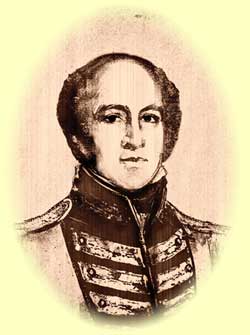 The May of 1839 was no different than last year's: here in Scotland, it had
always been a month when the weather finally settled, marking the cyclical
change from the gloom of winter to the buoyancy of summer. The sun was
generously spilling its rays over a large Georgian house as if trying to warm
up its walls, clammy from the late night frost. Some bolder sunbeams ventured
through the sash-window and landed on the face of a man in his late sixties,
sitting in front of a black marble fireplace lit by obliging servants. Their
warmth-loving master had spent 30 years in the Asian tropics and had been once
referred to – unofficially, though – as the Raja of Malacca...
The May of 1839 was no different than last year's: here in Scotland, it had
always been a month when the weather finally settled, marking the cyclical
change from the gloom of winter to the buoyancy of summer. The sun was
generously spilling its rays over a large Georgian house as if trying to warm
up its walls, clammy from the late night frost. Some bolder sunbeams ventured
through the sash-window and landed on the face of a man in his late sixties,
sitting in front of a black marble fireplace lit by obliging servants. Their
warmth-loving master had spent 30 years in the Asian tropics and had been once
referred to – unofficially, though – as the Raja of Malacca...
...William Farquhar, a descendant of the ancient Scottish clan of
Farquhar –
(meaning “honest” or “beloved man” in
Gaelic) – had lived up tohis forefathers' name. True to the chosen path of a British soldier, he won
andenjoyed the genuine respect
of those around him, regardless of the race or
status. His was a life full of adventures, discovery, diplomatic games,
friendship, love and betrayal.
His career began at the East India Company, initially a commercial trading
company that over time became a virtual ruler
of India and some Asian colonies.
Several years later, young Farquhar took part in a military expedition against
Dutch-held Malacca, was gradually promoted and finally appointed Resident and
Commandant of Malacca, one of the oldest and most powerful Malay sultanates
that owed its wealth to its trading port. Farquhar supervised both civil and
military offices there after the state had passed into British hands from the
Dutch.
The time he spent in Malacca was probably the happiest in his life... The
young and inquisitive official was entirely fascinated with the brave new
world of the sultanate, which was incredibly rich in history and imprinted with the
strong European influences of its previous conquerors. He busied himself
learning the Malay language and local customs,
and lived as man and wife with
a local girl, Antoinette Clement, the Malaysian daughter of a French officer,
with whom he had six children by her.
Fascinated by the tropical wildlife and natural history, Farquhar sent
servants to collect plant and animal specimens,
later commissioning artists
to paint the findings. The paintings comprised one of the best art collections of tropical
nature, worthy of being donated to the Royal Asiatic Society in London. When
ordered by the British government to demolish all Dutch-built structures in
Malacca, Farquhar engaged his diplomatic skills and persuaded the officials to
change their minds. Why blow up solid fortifications and holy places like
Christ Church that could still be of service and impart character
to the state that had become his new home?
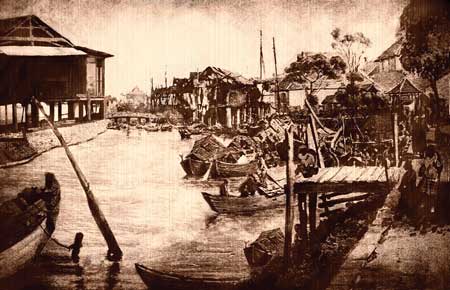 However, as a loyal servant to the British crown,
However, as a loyal servant to the British crown,
he was hardly ever a man of
free will. Instead, he was
a part of incessant political games to expand the
empire
at the expense of other lands... They changed the destiny of a nation
and his life... In 1818, he was forced to leave Malacca, his home of 15 years; it
had been handed back to the Dutch in compliance with the Treaty of London. Just
a pawn in a political game between two powerful empires thirsty for colonial
expansion, Britain and the Netherlands, Farquhar was about to set sail back
to Scotland.
But fate seemed to have other plans for the former
“Raja of Malacca”. Aware of
Farquhar's long Malayan experience, the British authorities ordered him to
assist Stamford Raffles, then Lieutenant-General of Bencoolen, the pepper
trading centre established by the British on Sumatra 200 years before, to
found a new settlement in the region. This settlement would later drive a wedge
between the two British officials...
...The old man opened his eyes, woken by a clanking sound. A servant
brought in a silver tea tray and was now serving tea, its rich amber
glistening when poured into a fine cup of bone china. Farquhar grinned: those two things
– chinaware and tea – were now taken for granted in Britain. And he, a mere
cog in the mammoth machine of the East India Company, had helped bring them to
Britain, along with other much-coveted Asian goods: cotton, silk, indigo dye,
opium and spices...
...Britain, striving to ensure lucrative trade with China, to watch closely
every move of the Dutch after they had gotten Malacca back, and to secure a passage
from India to the Chinese sea, desperately needed a new settlement in the
Malay Archipelago. Both Bencoolen and Penang were too remote. A new trading post
south of the Malaccan Straits was vital
for the British Empire.
After a brief survey of a number of islands, no Dutch presence was
established on the island of Singapore, about 200 miles south of Malacca.
Back then, Singapore belonged to a Malay ruler, Hussain Shah, who, in the tradition of
maritime Malay sultans, collected taxes and received tributes from the
captains of Asian trading vessels calling at his port. The island was also controlled
by a Malay temenggong (chief of police), Abdul Rahman. Raffles and Farquhar were
facing a challenging task of winning over the two men and gaining their
consent to cede the strategically advantageous island to Britain.
28 January, 1819. It was about four in the afternoon, the heat subsiding,
the day slowly yielding to the early tropical night. Several ships, with two
Englishmen aboard one of them, anchored about half a mile off the mouth of the
Singapore River. Sprawling along the coastline, there was a Malay village.
Farquhar was immediately taken by the serenity and simplicity
of the landscape,
so different from the hustle and bustle of Malacca. A few goods-carrying,
mat-sheltered sampans and light fishing koleks were floating idly on the calm
waters; some Malay boys were playing among the giant coconut trees;
a pungent smell of sun-dried fish was filling the air. Behind the temenggong's village
was nothing but boundless uninhabited virgin jungle.
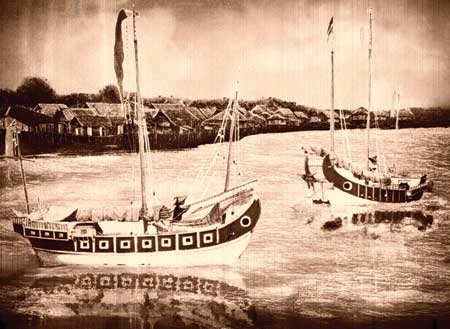 The following morning, Farquhar and Raffles came ashore. To show their
peaceful intentions, they brought with them only one sepoy carrying a musket. At
the temenggong's house, they were expected and welcome. The swarthy face of the
local chief wreathed into a smile, his hands holding a wooden platter heavy
with rambutans and other local fruits. Raffles led the negotiations
The following morning, Farquhar and Raffles came ashore. To show their
peaceful intentions, they brought with them only one sepoy carrying a musket. At
the temenggong's house, they were expected and welcome. The swarthy face of the
local chief wreathed into a smile, his hands holding a wooden platter heavy
with rambutans and other local fruits. Raffles led the negotiations
in Malay. He expressed the wish for Singapore to become
a British trading port and
explained how the trade would help the inhabitants. Besides, both the Sultan
and
the temenggong could count on generous annual rents
of 5,000 and 3,000 Spanish dollars respectively.
The two Malay rulers were not to let the cash slip away and, on 6 February
1819, both the Sultan and the temenggong signed a treaty with Raffles, which
granted the East India Company permission to establish a “trading
factory” in Singapore. It would take another five years and another treaty
for Singapore to
officially become a British colony. In the meantime, the historic deal was
sealed with a sumptuous banquet, during which gifts – mostly opium and
arms - were exchanged and the Union Jack was hoisted.
The next day, Raffles appointed Farquhar the First British Resident and
Commandant of Singapore and instructed him, before sailing back to Bencoolen,
to develop the settlement in accordance with his own specific plan, a plan
which would later become the stumbling block in Raffles and Farquhar's
relations...
In his new position, Farquhar faced serious challenges which Raffles had
never taken into consideration. Having proclaimed Singapore a free port, Raffles
exempted merchant ships from all sorts of taxes: import and export duties,
tonnage, port
and anchorage duties and port clearance fees. No doubt, it
proved extremely attractive to Chinese merchants who had
to pay high duties in
Dutch-controlled ports, but for Farquhar, it was a recipe for disaster.
The lack of revenue meant having to carry our Raffles' ambitious plans on a
shoestring. Farquhar turned to the senior officers in Calcutta for help,
but they were not inclined to invest in public works. He had no choice but to
pay for a number of expenses out of his own pocket. Raffles was of no assistance,
either. Stationed in the West Sumatra, he was unable to tend to urgent
matters
due to a poor postal service.
Out of despair, Farquhar resorted to revenue farming - he auctioned
monopoly rights from the state for the operation
of gambling dens and the sale of
arrack and opium. Cockfighting, gambling and the slave trade as licensed activities
ensured a much-needed cash flow.
... Some memories were pleasing and warming, like the hot tea he was
sipping. Indeed, he had a right to be proud - it was he who, against heavy odds and in
a mere four months, transformed a rural Malay settlement into a busy
cosmopolitan town. Many Asian merchants, knowing him to be a wise and reliable man from his
earlier Asian period, took up his invitation to come to Singapore and start
new businesses there. Indigenous sampans and koleks soon looked like tiny
splinters when passed by Chinese junks with their arched sides, frigates, schooners and
sloops calling at Singapore.
The range of goods they were carrying was
enormous: silk and porcelain from China, hemp from the Philippines,
cotton and dyes from India, rice and spices from Indonesia...
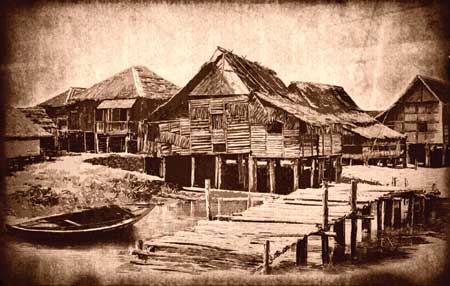 ...Under his direction, impenetrable jungle game way ...Under his direction, impenetrable jungle game way
to new timber houses with
traditional Malay attap roofs and open verandas; wide roads, including High
Street where Farquhar built his residence, were being laid. Pepper, cocoanuts,
pineapple, nutmeg and gambier trees were grown by an expanding Chinese
community.
It was he who successfully brought a major threat
to Singapore's settlers – rats under control. Incredibly huge and ferocious, they were
reported to have attacked cats that initially were the only hope of wiping the
rodents off the island. Offering commoners a shilling for every rat caught
helped rid Singapore of the pests in a fortnight and once again consolidated
Farquhar's reputation as a wise administrator.
By the end of 1820, Singapore's trade had already exceeded that of Malacca
during its most prosperous period.
The number of Singapore's inhabitants grew
from 200 to over 6,000 and kept rising. The Dutch were incensed
by the strengthening position of Britain in the region. Thyssen, the Dutch Governor
of Malacca, even threatened
to sail to Singapore and bring Farquhar back in
chains. A professional soldier, Farquhar had first-hand knowledge
of a settlement defences and had a fort built behind the Malay village,
strategically positioning it right by a freshwater creek. He was determined
to repulse any enemy, despite having only 340 men and 12 guns at his
disposal.
Delighted with the settlement's rapid transformations, Raffles was
nonetheless furious at many aspects of Farquhar's administration whose desperate
measures – allowing gambling dens and slavery - outraged Bencoolen's
Governor
as disgraceful and vice-encouraging. But what angered Raffles most
was that Farquhar allowed to build houses
and godowns on the north bank of the
Singapore River which he had set aside for governmental use. Raffles had
allocated the Beach Road area to merchants who later complained to Farquhar
that it was low, swampy and subject to continual surf, which made the ground
unsuitable for either erecting buildings or landing goods from ships. To
Farquhar, the development of the commercial district was a priority over a
Government House, so he let the merchants have the reserved plots.
Having to act under the immediate supervision of a younger man, a junior
official at that, who failed to understand
the actual situation, was frustrating for Farquhar. Tensions had been growing and, on 28 April 1823, the
differences between the two came to a head - Raffles dismissed Farquhar as
Resident “with effect from 1 May”. Three weeks later, Farquhar was
removed as Commandant, too...
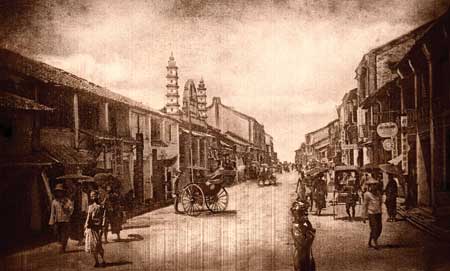 Humiliated and bitter at the dismissal, Farquhar stayed on the island till
the end of 1823. At a farewell dinner, Farquhar was presented with a large
silver epergne,
Humiliated and bitter at the dismissal, Farquhar stayed on the island till
the end of 1823. At a farewell dinner, Farquhar was presented with a large
silver epergne,
the commissioned work of London silversmiths –
a gesture of never-ending respect and admiration from
the local communities. On his day of
departure, as later reported by a Calcutta newspaper, a motley crowd
of Singapore's inhabitants, both European and Asian, accompanied their
ex-Commandant to the beach,
with the troops forming a guard-of-honour from his
house to the landing place. Singapore's First Resident embarked under the
sounds of salute customary to his rank. Numerous boats accompanied him to his
ship, the Alexander, and as they sailed, some of the Siamese vessels fired
salutes in his honour...
...He could not help but think that the major difference between the two of
them was of a personal nature. The two men were no total strangers, having
participated in the same missions and shared a genuine affection for the
Malays. However, Raffles felt that the white man had o keep a certain distance
from the locals, and he was not beneath laughing at Farquhar's local family,
whom he archly called a “Malay connexion”. Prim and proper and
convinced that he was always right, Raffles reported Farquhar as having moved away from
“the usual etiquette in dispensing with the military dress of his rank,”
when he found out about the Commandant's new habit of wearing a sarong...
...The old man moved his eyes from the fanciful dance of the flames. The
servant gone and the table cleared, he was now once again alone with his thoughts.
The ancient maxim was wrong: time had proved a poor healer. It had failed to
soothe the pain of insult inflicted by Stamford Raffles. Sensing that the bygone
grievance was about to rekindle, Farquhar pulled the plaid up to his chin,
seeking comfort in its warmth. But it brought him little relieve, as his
treacherous mind kept taking him 16 years back, evoking his own letter to
Raffles, written in the nervous hand of a hardened soldier wrongfully
dismissed:
«...Nothing has been wanting on my part to advance the prosperity of
this Settlement by every means in my power,
that our Political and Commercial
relations with all the surrounding Native States throughout the Eastern
Archipelago,
the Malay Peninsula, the Eastern coast of Sumatra, together with
the kingdoms of Siam, Cambojia and Cochin China, have been supported,
cultivated and improved, both by extensive epistolatary correspondence as well
as every other suitable and available means within my reach... the
establishment generally during the period I have had the honour
to direct
its affairs, has attained to a height in population, wealth and general prosperity I may
venture to say quite unrivalled.»
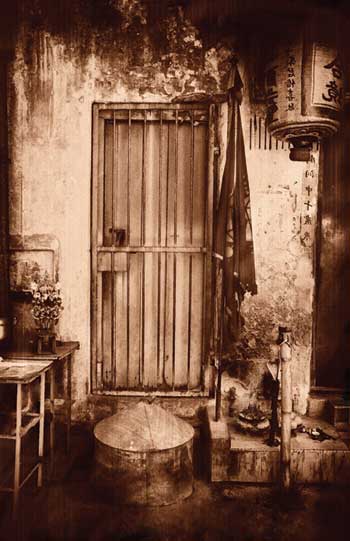 A rather muddled and lengthy letter, aimed to reach out to Raffles'
conscience, and failing to do so, a cry from his heart that was never
heard... It was followed by Farquhar's statement to the Court of Directors of the East
India Company, in which he requested his rightful reinstatement and asserted his
right as the founder of Singapore. It bore no fruit except to get him promoted
to the rank of Major-General. What a measly compensation for everything he had
done for Singapore! A rather muddled and lengthy letter, aimed to reach out to Raffles'
conscience, and failing to do so, a cry from his heart that was never
heard... It was followed by Farquhar's statement to the Court of Directors of the East
India Company, in which he requested his rightful reinstatement and asserted his
right as the founder of Singapore. It bore no fruit except to get him promoted
to the rank of Major-General. What a measly compensation for everything he had
done for Singapore!
...How many times did he try to keep his charging at bay and not argue with
the late antagonist (Raffles had died three years after dismissing Farquhar). That
Raffles was a visionary Farquhar had never failed
to admit. And yet, while
describing Singapore as “his Child” and
“his
Colony”, Raffles could have at
least admitted his, Farquhar's role
of a doting mother who had nursed the
infant settlement during its first four years...The old man got off the chair
with difficulty and stepped out into the garden that was preparing to burst
into blooming in a matter of days. The changing of the seasons – that was
what he had missed most while residing in the eternal summer of Malacca and
Singapore. He smiled and walked pensively down the cobbled path, unaware
of that that May would be his last...
... Farquhar died on 11 May 1839. He parted this world, never reconciled
with his role as Raffles' assistant in forming the settlement
of Singapore. His tombstone's inscription reads the following:
“...During 20 years of his
valuable life he was appointed to offices of high responsibility under the civil
government of India having in addition to his military duties served
as Resident in Malacca and afterwards at Singapore which later
settlement
he founded...”by Julia Sherstyuk
|  +65 6696 7068
+65 6696 7068
 info@meridian103.com
info@meridian103.com
 PDA
PDA
 +65 6696 7068
+65 6696 7068
 info@meridian103.com
info@meridian103.com
 PDA
PDA